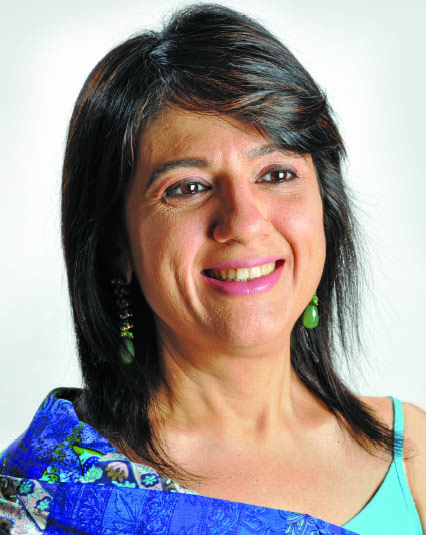- Home
- Archive -Oct 2010
- Rice is nice

Rice is nice
- In :
- Personal Growth
By Naini Setalvad
October 2010
This much-maligned popular comfort food is in reality, healthy and fat-free!
There are so many myths and misunderstandings about food in general. Many of us avoid a particular food, because we think it is unhealthy. One of the most maligned food items is rice.
How is this possible, when all of us have grown up with rice as a part of our daily diet? A typical Indian meal is incomplete without rice. However, for those who are weight-conscious, rice is forbidden fruit. For a long time I was deprived of this wonderful grain as I was told it was fattening. All my weight-loss strategies hinged around boycotting rice. When my parents turned diabetic, rice was rarely cooked at home. When I turned nutritionist, I continued the embargo on rice with numerous diabetic patients who came to me for nutritional advice. Today, I advocate it freely to my clients and I too enjoy the satisfaction of a complete meal.
Rice is an intrinsic part of our culture, heritage and diet. No ceremony is complete without rice. A bride is welcomed to the house with rice. It is an intrinsic part of pooja materials along with haldi and kumkum. In Bengal, a special ceremony is performed a few weeks after a child is born, where the first food the child is given after the mother’s milk is rice. Rice is eaten in almost all parts of India. It is the staple grain of the south, east, and coastal regions of the country. The entire Far East survives on rice, and is one of the healthiest populations with the least incidence of heart disease, and cancer. They have high longevity, and most of them lead relatively disease-free lives.
Rice is comfort food. When ill, all one longs for is khichdi made with moong dal and rice. In the South, nothing equals rice kanji for convalescents. The ubiquitous dal chawal is soul food, no less. A party spread without a scrumptious pulav or biryani is unthinkable. Why then do we believe that rice is bad for health? Nutritionally speaking it contains zero fat, and a hundred grams of rice contains as many calories as a hundred grams of any other grain. Here are some other benefits of rice:
• In technical terms, rice is a complex carbohydrate which is easy to digest. No wonder rice kanji is a quick fix for diarrhea. Cooking a combination of rice, curds, some jeera and salt makes the traditional Gujarati ghainsh (curd rice), which is a miracle for the digestive system, and a standard meal for people who are unwell, or with a weak digestive system.
• Rice contains zero sodium and zero cholesterol, thus being extremely healthy for everyone, including those suffering from hypertension.
• Believe it or not – rice contains practically no fat, is gluten-free, which means it does not irritate the digestive system. Many people have gluten allergy, and rice, therefore, is suitable for them. 100 grams of rice contains the same calories as 100 grams of any other grain. If consumed in moderation, like any other food, it is healthy. An average 100 gram serving of rice contains just 0.4 grams of fat! In fact, this is approximately the same amount of calories as whole wheat or any other whole grain and therefore it is the same as having 100 grams worth of rotis, and certainly a better option than maida parathas, naans, roomali rotis, white bread, or even worse – fried puris.
• Unpolished rice contains more fibre and definitely should be chosen over white rice. But remember finally it is not the colour of the rice that matters but the glycemic index of the rice. The lower the glycemic index of the rice the healthier it is. It keeps you full for a longer time, does not allow the blood sugar to spike, and is excellent in maintaining blood sugar levels, sugar fluctuations, thus making it good for diabetics. That’s why it is important to choose a low glycemic index rice whether it is polished or unpolished.
Also, remember not to throw out the water in which the rice was cooked, as it is full of nutrients. Rice tastes best when cooked on a slow flame. Accompany your rice with generous helpings of vegetables and a protein-rich dal or fish curry. Mmmh! Food for the gods!
Naini Setalvad is an obesity and health food consultant, columnist for leading newspapers and conducts workshops on healthy eating. Contact: healthforyou@vsnl.net
To read more such articles on personal growth, inspirations and positivity, subscribe to our digital magazine at subscribe here
Life Positive follows a stringent review publishing mechanism. Every review received undergoes -
- 1. A mobile number and email ID verification check
- 2. Analysis by our seeker happiness team to double check for authenticity
- 3. Cross-checking, if required, by speaking to the seeker posting the review
Only after we're satisfied about the authenticity of a review is it allowed to go live on our website
Our award winning customer care team is available from 9 a.m to 9 p.m everyday
The Life Positive seal of trust implies:-
-
Standards guarantee:
All our healers and therapists undergo training and/or certification from authorized bodies before becoming professionals. They have a minimum professional experience of one year
-
Genuineness guarantee:
All our healers and therapists are genuinely passionate about doing service. They do their very best to help seekers (patients) live better lives.
-
Payment security:
All payments made to our healers are secure up to the point wherein if any session is paid for, it will be honoured dutifully and delivered promptly
-
Anonymity guarantee:
Every seekers (patients) details will always remain 100% confidential and will never be disclosed
